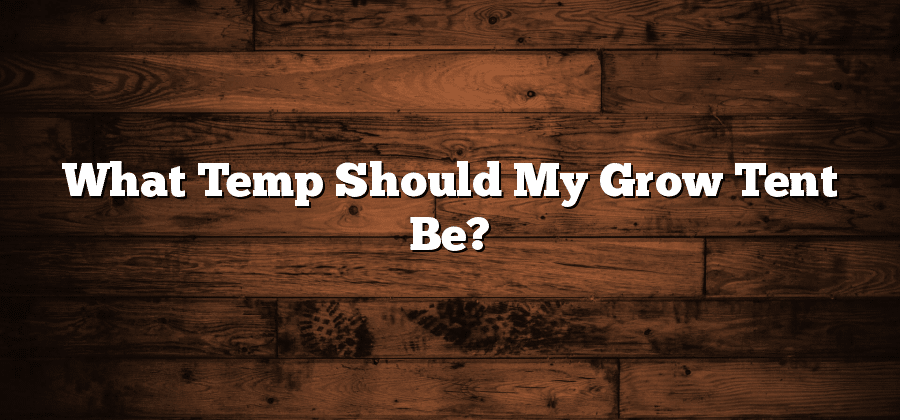Ideal Temperature for Optimal Plant Growth
Plants have specific temperature requirements for optimal growth and development. Maintaining the ideal temperature in your grow tent is crucial to provide the best conditions for your plants to thrive.
Different types of plants have varying temperature preferences, but generally, a temperature range of 65-85°F (18-29°C) is considered ideal for most plants. This temperature range provides the right balance between promoting photosynthesis and ensuring that the plants are not under stress. However, it is important to note that some plants, such as tropical or heat-loving plants, may require higher temperatures to reach their full potential. On the other hand, cool-season crops may prefer slightly lower temperatures for optimal growth.
Maintaining an ideal temperature in your grow tent involves careful monitoring and control. Factors such as the intensity of light, ventilation, and external climate can influence the temperature inside the tent. It is essential to invest in a good quality thermometer to accurately measure the temperature, as slight variations can significantly affect plant growth. Implementing appropriate ventilation systems, using fans or air conditioning units, can help regulate the temperature within the desired range. Additionally, adjusting the lighting intensity or employing shading methods can also help in controlling the temperature inside the grow tent. By paying close attention to temperature management, you can create the ideal conditions for your plants to flourish and maximize their growth potential.
Factors Affecting Temperature in Grow Tents
The temperature within a grow tent plays a crucial role in the overall success of plant growth. Various factors can affect the temperature inside a grow tent, and understanding these factors is essential for providing optimal growing conditions for plants.
One of the main factors affecting temperature in grow tents is the ambient temperature of the surrounding environment. The temperature outside the grow tent can have a direct impact on the temperature inside, as it influences the heat exchange through the tent walls. Additionally, the presence or absence of insulation in the tent can also affect the temperature inside. Insulated tents are better at retaining heat, while non-insulated ones may require additional heating or cooling measures to maintain suitable temperatures. Proper consideration and adjustment of these factors are necessary to create a favorable environment for plant growth within the grow tent.
Understanding the Relationship Between Temperature and Humidity
The relationship between temperature and humidity is a critical factor to consider when it comes to successful plant growth in grow tents. These two variables are closely interconnected and can significantly impact the overall health and productivity of your plants. Understanding this relationship is essential for achieving optimal conditions and maximizing the potential of your grow tent setup.
Temperature refers to the measurement of heat in a given environment, while humidity represents the amount of moisture in the air. These two factors work hand in hand, influencing each other and affecting plant development in numerous ways. High temperatures can often lead to increased humidity levels due to enhanced evaporation, while low temperatures can result in reduced moisture content. Finding the right balance between these two variables is key to creating a favorable environment for your plants to thrive.
The Importance of Temperature Control in Grow Tents
Temperature control is a critical factor in achieving successful plant growth in grow tents. Maintaining the ideal temperature within the grow tent promotes optimal growth and development of plants, ensuring they reach their full potential. Without proper temperature control, plants may struggle to thrive, resulting in stunted growth, reduced yield, or even complete failure.
One key reason temperature control is important in grow tents is because plants have specific temperature requirements for various stages of growth. For example, during the vegetative stage, plants typically thrive in temperatures between 70-85°F (21-29°C), while the flowering stage often requires slightly lower temperatures of 65-80°F (18-27°C). Failure to provide the appropriate temperature can disrupt the biological processes of plants, leading to physiological stress and negative impacts on overall growth. Additionally, fluctuations in temperature can disrupt the plant’s internal clock and trigger undesirable responses, such as premature flowering or delayed maturity.
Common Temperature Mistakes to Avoid in Grow Tents
Temperature control is key when it comes to successful indoor gardening in grow tents. However, there are several common temperature mistakes that growers often make. One of the biggest mistakes is failing to monitor the temperature consistently. It is crucial to regularly check and maintain the temperature in the grow tent to ensure that it remains within the optimal range for plant growth. Another common mistake is setting the temperature too high or too low. Extreme temperatures can have adverse effects on plants, causing stunted growth, leaf damage, or even death. It is important to research and understand the specific temperature requirements of the plants being grown and to adjust the temperature accordingly.
Proper insulation is also crucial in preventing temperature fluctuations. Many growers make the mistake of not properly insulating their grow tents, which can lead to heat or cold loss. Insulating the tent with reflective materials like Mylar or using insulation blankets can help maintain a stable temperature and prevent energy wasted. Furthermore, some growers overlook the importance of ventilation and airflow in temperature control. Poor ventilation can result in temperature and humidity imbalances, as well as the buildup of CO2, which can harm plants. It is essential to invest in a quality ventilation system that provides adequate airflow and helps to regulate the temperature effectively. By avoiding these common temperature mistakes and implementing proper temperature control strategies, growers can create an ideal environment for their plants to thrive in grow tents.






